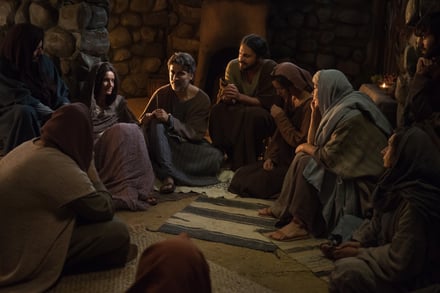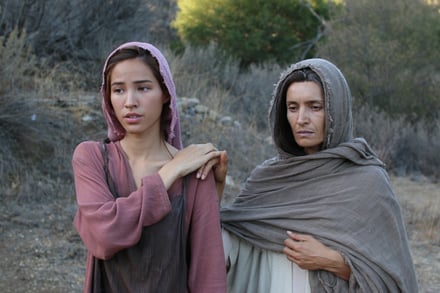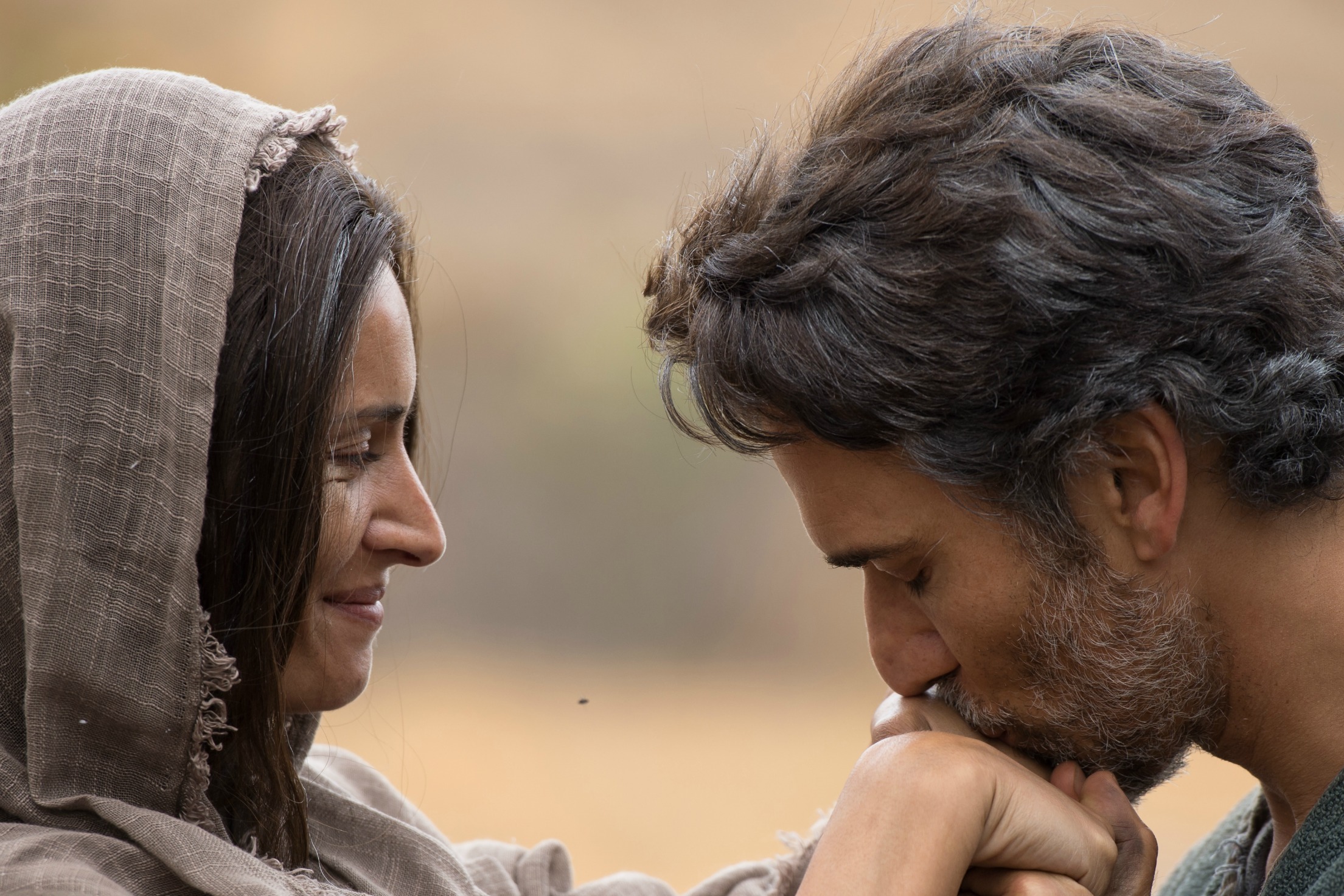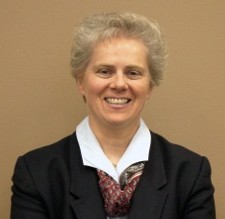For more than a century, the Blessed Virgin Mary has caught the imaginations of filmmakers of all religious persuasions: devout believers, agnostic, and even atheist affiliations. The intersection of theology and secular culture presents the monumental challenge to filmmakers of depicting what escapes all visual categories: Transcendence and Mystery. The cinematic depictions of Mary of Nazareth range from being in harmony with the Christian faith to sacrilegious portrayal and caricature.
One day after the Solemnity of the Annunciation (celebrated this year on April 4), the Institute for Church Life was privileged to host a screening of Full of Grace, a feature film depicting the early Church ten years after Christ’s Ascension. The film, written and directed by Andrew Hyatt, is unique in that it portrays an aging Mary, one decade after Pentecost leading up to her Assumption.
The public event, attracting more than two hundred people, was one of three belonging to an undergraduate course called Mary in the Movies. During six weeks of intensive learning, nearly forty students familiarized themselves with the portrayal of Mary of Nazareth onscreen. The course examined a variety of films in view of their scriptural, doctrinal, and spiritual accuracy. The introductory lecture was given by Dr. Catherine O’Brien, author of The Celluloid Madonna: From Scripture to Screen. Dr. O’Brien, who is a Senior Lecturer at the University of Kingston in England, set the scene by drawing on contextual information relative to the transfer of the image of the Virgin Mary to the screen. She focused on feature films that relate incidents from Mary’s earthly biography as the mother of the Savior, and her role as the first disciple of Jesus. A second public lecture concluded the course. Mr. Michael Duricy, S.T.L. from the International Marian Research Institute of Dayton, Ohio, interpreted Marian Allusions in Film.
The screening of Full of Grace was the second public event. It featured the last phase in the life of the Blessed Virgin Mary, of which the Bible is silent. What happened to Mary after her Son’s Ascension to the Father? Did she join St. John in Ephesus or did she stay in Jerusalem? How important was Mary’s role in the formation of the Apostles and of the early Church? How old was she when she left this earth? What actually happened at her Assumption? These and many other enigmas needed to be actively imagined and addressed by the film team. Full of Grace is a production of Outside da Box, an apostolate devoted to the creation of Catholic video resources for catechesis. The film has received international acclaim for raising the faith-based film industry to a new benchmark of spiritual enrichment. We were privileged to welcome Eric Groth, the Executive Producer and President of Outside da Box, representing the ministry and the film; Dr. John Showalter, Executive Producer; and T.J. Berden, Producer. The three gentlemen related their desire to produce authentic Catholic films and catechetical materials. Their introductory remarks concluded with a prayer, asking for the gift of a Marian pondering upon “all present so that they take the time to reflect on what this movie is saying to them.”
In what follows, I would like to let the students who took the course (mainly undergraduate juniors and seniors), describe and evaluate the film. Each one wrote a short reflection on an aspect of the 83-minute movie or on the subsequent 45-minute discussion. Some students conveyed their overall impression; some commented on the actress portraying Mary (Bahia Haifi); others noted the scenery, the musical score, or events surrounding Mary’s last days on earth. Accordingly, I will focus on the categories created by the students’ own reflections, and thereby allow each one of them to contribute to this evaluation of the film.
I had never considered what life must have been like for Mary after the Death and Resurrection of her beloved son.
There was a common thread running through the student evaluations. They stated that they hardly ever thought of how Mary’s life continued after Pentecost. “It was amazing that, though raised Catholic and having attended Catholic school all my life, I had never considered what life must have been like for Mary after the Death and Resurrection of her beloved son . . . and I felt that my Catholic understanding of and appreciation for Mary was further increased by viewing Full of Grace.”
Film Setting
The movie stimulates a prayerful potential and an interior receptivity in the
viewer. “The filming itself and the accompanying music really touched me.” Another student noted “a lot of silence as well as some use of violins and of two pieces by Hildegard of Bingen.” To still another student, “the generally successful attempts to create historical accuracy” were impressive. “Casting actors of Mediterranean and Middle Eastern descent, using historically accurate clothing, creating convincing props, and choosing a location that resembles the area around Jerusalem all added to the movie.” One student found it remarkable how “nature played an integral part; . . . Mary, is depicted living in complete harmony with the natural world, both in the dream-like portrayal of her youth and in the final days of her life on earth.” The “effects of shadow and light and the many flashbacks, especially to the scene of the Annunciation and to the scene of Peter’s calling to become a fisher of men invite meditation on the significance of God’s calling.”
Mary’s Personality
The majority of students were captivated by the portrayal of an older, more mature Mary who “conveyed a calm wisdom and a source of strength and guidance for the disciples, especially Peter.” She “exudes a maturity and understanding beyond all earthly knowledge.” Comparing and contrasting “the post-resurrection Mary with her younger self,” one student was touched that “she was just as motherly . . . to the disciples as she was to her growing Son Jesus.” At the same time, another emphasized, “she seemed more reflective and sure of her relationship with God” after Easter.
Mary’s Role
Mary’s position in the nascent Church “is an important part of Mary’s life that I had not considered much; . . . this movie illustrates the importance of Mary’s leadership as Jesus’ first disciple. . . . She actively seeks to spread the Good News and encourages the other disciples to do the same, despite the fear of persecution and bloodshed.” A student deduced that while so little is known about Mary’s day-to-day involvement with building up the Church, “it is not difficult to imagine what a perfectly moral being would do in those situations.” From crib to Cross, Mary “is recognized as an influential player during Jesus’ life, and rightfully so, but I think her post-Resurrection importance is not analyzed enough.” Having known the Lord from the first moment of his human existence, “it is evident that she . . . is able to reflect back on her life with wisdom to tell.” As the “original” disciple of the Lord, “Mary was at the forefront,” thereby “reassuring the Apostles of their mission, making them believe in both themselves and the will of God.” Moreover, “I loved how Mary was portrayed in a way that embraced her role as mother to the rest of the world.”
 While we know from Scripture “that Peter was given the power to lead the Church, Mary seems more like the person in charge.” Her conversations with the Apostles were “about very real issues.” On Golgotha, a second dimension of Mary’s motherhood was revealed: “Mary’s new task was to be the Mother of all of us. Those men in the early Church especially needed a motherly figure after the passing of their best friend and teacher, and it makes much sense to me that she would stay” with them. “It is interesting to note that Mary presented in this manner portrays a fulfillment of the scene at the foot of the Cross in which Jesus gives John to Mary and Mary to the Church as mother of all.”
While we know from Scripture “that Peter was given the power to lead the Church, Mary seems more like the person in charge.” Her conversations with the Apostles were “about very real issues.” On Golgotha, a second dimension of Mary’s motherhood was revealed: “Mary’s new task was to be the Mother of all of us. Those men in the early Church especially needed a motherly figure after the passing of their best friend and teacher, and it makes much sense to me that she would stay” with them. “It is interesting to note that Mary presented in this manner portrays a fulfillment of the scene at the foot of the Cross in which Jesus gives John to Mary and Mary to the Church as mother of all.”
Too often in our own lives, in a world full of Type-A personalities, we try to micromanage our faith, as opposed to putting our full trust in the Lord.
Several students reflected on “Mary’s response to Peter’s struggle to lead the new Church” of 43 A.D. When “Peter struggles . . . and questions his place as the leading figure,” Mary advised him to lead by following that path that Jesus had already paved for him. A few students struggled with the portrayal of a weak Peter. “I had imagined Peter’s work to be near perfect after the resurrection but . . . Full of Grace seems to depict the spiritual infant Simon, who though destined to be the Rock, has not yet grown into the man whom Christ has made him. Undoubtedly the real Peter as the first Pope still resembled Simon, but his weakness would have become his strength because it required his total, active, and intentional reliance upon God.” Yet, the movie addresses the popes and Church members of all ages. “I think too often in our own lives, in a world full of Type-A personalities, we try to micromanage our faith, as opposed to putting our full trust in the Lord. The film reminded me how much grace, beauty, and strength Mary had throughout all of the struggles she endured.” Mary’s key role in the early Church as well as in the Church of the third millennium is that of a mother and teacher. “By telling the story of Jesus through memories, Mary is able to express what she wants us to learn from Jesus.” Her final words, cited by several students, assure us of her maternal solicitude: “Like him I will never leave you, I will be with you until the end of days.”
Although Jesus does not appear in the movie, he is kept alive through Mary. “The stories Mary told really gave us a hint of her life with Jesus.” For example, while walking with Peter she retraced the steps of her Son, informing him: “I take this walk to remember him, and then all complications of life disappear.” Through these examples, “Jesus was a vital character in this movie, though never physically portrayed on screen.” One student found “extremely interesting and thought-provoking . . . how the director and screenwriter chose to portray Jesus. . . . When Jesus had a role in a particular scene, the viewer never saw what he looked like. . . . It was as if the camera were his eyes and the viewer saw his perspective. I thought that this was a very creative focus on Jesus through Mary.”
In Full of Grace, Mary has adopted Zara, a fictional young woman who was orphaned in infancy. “It was interesting to me how Zara speaks to Peter about Mary. Peter asks how Zara is so faithful and is able to firmly believe in the Lord though she never . . . saw him. She replied, ‘I see him in her. I hear him because of her.’ . . . I think this is very indicative of who Mary is and what she signifies. Her powerful presence did not fade after Jesus left, she is still [showing] the way to Jesus, even now.”
Interpretation of the Assumption
The students’ reactions to the movie’s depiction of the end of Mary’s earthly pilgrimage were generally positive. Their reflections revealed their apprehension, ranging from curiosity to worry “as to how the Assumption would be portrayed”; after all, we do not “have many writings on her death and assumption.” In the film, Mary dies an extraordinary death and her body is buried. Thereby the film clearly indicates her participation in the Lord’s Death and Resurrection, although “there’s no showing of an empty or flower-filled tomb and thus no grand finale in the Hollywood style.” Here are some impressions from the audience: “I appreciated how tasteful[ly] the filmmakers depicted the Virgin in her final days.” The portrayal of “her ‘death’ and funeral were powerful scenes.” They placed a seal on a life totally dedicated to Jesus Christ and “seamlessly accentuated Mary’s role as a nurturing, wise mother, guiding Jesus’ disciples and, to an extent, the Catholic Church.” Many liked the portrayal of Mary’s farewell words to the Apostles and her subsequent falling asleep since this “connects to our humanity and lets us mourn and celebrate Mary’s life.” One student was startled by how readily Peter accepted Mary’s passing. “That particularly seemed like a weird response; . . . [since it] doesn’t parallel . . . any funeral I have ever been to.”
 A few students critiqued the choice to “depict Mary’s death” since it lifts the veil of the mystery surrounding her end of life. “I was surprised that the film elected to depict Mary’s death. This seems to reopen the question of whether Mary actually died or was rather just assumed into Heaven.” “I had never heard this notion [of Mary’s death] before, and had always assumed that Mary had been assumed into heaven before she died.” The producers explained that the papal bull defining Mary’s Assumption Munificentissimus Deus (§176) is ambiguous about her transitus. The portrayal of Mary’s falling asleep and her funeral are not contradictory to the dogma “that the Immaculate Mother of God, the ever Virgin Mary, having completed the course of her earthly life, was assumed body and soul into heavenly glory” (MD §44). One student noted that, since we lack an accurate account “about the life of Mary after Jesus’ Death and Resurrection . . . I feel that the producers of Full of Grace offered the viewer an occasion to reflect at greater lengths on the dormition of Mary, which we focus on each time we pray the Rosary.”
A few students critiqued the choice to “depict Mary’s death” since it lifts the veil of the mystery surrounding her end of life. “I was surprised that the film elected to depict Mary’s death. This seems to reopen the question of whether Mary actually died or was rather just assumed into Heaven.” “I had never heard this notion [of Mary’s death] before, and had always assumed that Mary had been assumed into heaven before she died.” The producers explained that the papal bull defining Mary’s Assumption Munificentissimus Deus (§176) is ambiguous about her transitus. The portrayal of Mary’s falling asleep and her funeral are not contradictory to the dogma “that the Immaculate Mother of God, the ever Virgin Mary, having completed the course of her earthly life, was assumed body and soul into heavenly glory” (MD §44). One student noted that, since we lack an accurate account “about the life of Mary after Jesus’ Death and Resurrection . . . I feel that the producers of Full of Grace offered the viewer an occasion to reflect at greater lengths on the dormition of Mary, which we focus on each time we pray the Rosary.”
A Tool for Evangelization
The filmmakers emphasized that Full of Grace can be a powerful catechetical tool. The movie can be watched in segments supplemented by Lectio divina and/or teaching. The idea is to guide the viewer to a personal encounter with Mary of Nazareth. The audience was impressed by the “Outside da Box gentlemen’s true belief . . . Their faith was clear and inspiring.” Students also commented that “the producers and screen writers did their homework before releasing the film” by consulting bishops and theologians “to be certain that what they were portraying was in line with what the Catholic Church taught.”
“In general, I found the film very thought-provoking in many ways, both on a spiritual and intellectual level.” Mary’s person, witness, and role are as pivotal and inspiring today as they were 2000 years ago. She “invites us to follow her example as a model of unconditional faith in God.” While “we can never achieve the virtue of Immaculate Mary I can strive to emulate her in every aspect of my life.” Several students commented on “Mary’s advice to the Apostles: ‘We listen, we follow, and we trust.’ I thought that that was the most beautiful line of the whole film, and really was a lesson that was emphasized throughout the film, especially in Peter’s struggle over how to move the Church forward.”
Faith is not about experiencing things, it is about living and breathing the light that is upon us.
Another line that “really stuck” with another student was: “‘Faith is not about experiencing things, it is about living and breathing the light that is upon us.’ It really made me think about how I see my faith and if I am taking advantage of being in the light of Our Mother here at Notre Dame.“ In general, the audience appreciated the maturity and wisdom emanating from the Mother of the Lord. Mary’s advice helped Peter then, but in a way it is timeless. Full of Grace emphasizes that the Marian dimension of the Church precedes the Petrine dimension although they are closely interwoven and complementary. The movie made it clear that Mary, like no other, knows and embodies the Church’s mission, and therefore the Church of all times is well advised to turn to and better understand Mary. Her words speak to us today: “Remember always, your heart is beating with his for eternity!” “Your fears and struggles are not unique” and “it is not a question of will you struggle, but who will you look to.” Mary’s words convey “the idea that we are never alone. Even in our darkest times, there is someone who has gone through those struggles before, and God is always with you.” Moreover, “Mary makes sure that we know that he lives within all of us even today. To me, this was very powerful because sometimes it can be hard to identify ourselves with the Lord Jesus after all our sins and trials . . . Mary tells us to not fear this; our struggles are Jesus’ just as Jesus’ struggles are our own.” For this reason, “I believe these [scenes] could be used in evangelizing people who are struggling in their lives especially college students who are under a lot of stress.”
General Echoes
In conclusion, here are some overall echoes from the audience:
- “This screening of Full of Grace was a truly great opportunity. I loved hearing how the movie was made. It isn’t every day that you get to meet with the director and crew.”
- “There are so many words that came to my mind after watching Full of Grace, but none of them can do justice to the beautiful film. Outside da Box has managed to create a unique viewing experience that left me both completely at peace and contemplative at the same time.”
- “This film, I think, was one of the most beautiful representations of Mary I’ve ever seen. Every time she appeared on screen, it almost felt surreal to have the Mother of God imparting such a personal message in such a vulnerable and willing manner.”
- “I really enjoyed this movie screening because it gave a completely new perspective on the story of the Passion. So often in Catholicism we don’t think about logistics of how people were supposed to continue to live and spread the Word of the Lord and explain the miracle of Jesus.”
- “As a Catholic, I think that this portrayal of Mary’s life at its end was exactly what I would like to picture it: she is loved and cared for by all of the people in her life, and she has a very real and profound connection with Jesus even after he is gone.”
- “I found myself in agreement with the producer’s and director’s sentiments. Prior to the show, one of the men emphasized that this was not a typical Hollywood movie. The film was meant to be a meditation on faith in the school of Mary.”
![]()
All images courtesy of Outside da Box productions.



